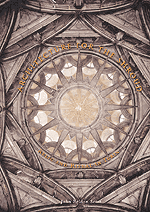"Architecture for the Shroud provides an original and wholly convincing interpretation of the Chapel of the Most Holy Shroud in Turin, one of the key monuments of Baroque architecture and the acknowledged masterpiece of Guarino Guarini. Written with remarkable clarity and grace, the book transcends earlier works by placing Guarini's chapel against the broad background of liturgical and dynastic ritual, as well as the remarkable history of the relic it enshrines."—John Pinto, Princeton University
"Architecture for the Shroud is an extraordinary historical investigation of published and unpublished documents, ranging from contemporary records and preparatory drawings to popular broadsides. Combined with this exemplary search for historic fact, Scott has given us a profound and satisfying art historical analysis of the very special architectural container for the shroud, Guarino Guarini's chapel, the SS. Sindone. In fact, Scott's contribution has a special value, for this may well be the last major study of the chapel to be written by a scholar who was deeply familiar with the chapel before its brutal transformation."—Malcom Campbell, The University of Pennsylvania
An excerpt from
Architecture for the Shroud
Relic and Ritual in Turin
by John Beldon Scott
Preface
This book began as a study of Guarino Guarini's late-seventeenth-century reliquary chapel, designed to house and display the object venerated in Turin as the burial cloth of Jesus. I was first attracted to this building and in particular its enigmatic dome simply because of its originality. I sought to know what it meant or at least how it came into being and how it functioned in the overall setting of the cathedral-palace complex in the Savoyard capital. Surely, I thought, the architect must have encoded such bizarre imagery with a special message to its intended audience. The intervention of time, of course, had now obscured for us that which must have been more readily understood by contemporary viewers. Setting for myself the task of reconstructing that original meaning, I applied the analytical methodologies of art-historical practice.
 Fulvio Lanza, trompe l'oeil perspective view of Chapel of the Holy Shroud, oil on canvas, 1998, Cathedral of San Giovanni, Turin. (Maurizio Momo) Larger image |
 Dome interior, Chapel of the Holy Shroud, Turin (Chromon) Larger image |
The formal ceremonies of public display represent revealing moments of opportunity and stress in which appear both the ambitions and the anxieties of the ruling elite. These were occasions for the exercise of centralized control, for the production of dynastic imagery, for the conversion of heretics, and for the increase of tax revenues; but they also inevitably presented certain risks to the regime, such as the spreading of contagion, civil unrest, and confessional dissent.
 Dome, Chapel of the Holy Shroud, Turin. (Chomon) Larger image |
If we follow Collingwood's theoretical model of the interpolating "a priori imagination" and link the ostensions one to another as "fixed points," we can chart the vitality of initiatives made by the dynasty in using the Shroud to achieve dominance in Piedmont, to transform Turin into the new absolutist capital, and to gain international recognition as a ruling house of royal rank. The architecture generated by the Savoy for displaying the relic, as we shall see, functioned as an instrument for political identity formation and for state building. The phenomenal success of the cult of the Shroud in Piedmont therefore cannot be divorced from the dynastic aspirations of the Savoy. I believe it no coincidence, for example, that Guarini's long-planned Shroud Chapel came to fruition just in the decades when the effort to achieve recognition for dynastic claims to a royal title peaked. Only in the course of this broader undertaking did I realize that Guarini's chapel cannot be only the isolated architectural tour de force it appears.
 Cupola (11 April 1997), Chapel of the Holy Shroud, Turin. (Pino Dell'Aquila) Larger image |
Calculated handling of the Shroud by the dynasty and the spectacular architectural settings provided for public relic display constitute a strong endorsement of Maravall's interpretation of the Baroque as a culture of visual persuasion. Here the power brokers behind the institutions of state and church deploy elaborate visual means to convince the masses of people of the transcendental validity of the social and political structures the ruling class sought to reinforce as instruments of domination. As ritualists put it, "pomp is itself a visible form of power". Architecture and ritual are the two most important mechanisms of ideological seduction we shall examine, and taken together, they exemplify the "theater state" as identified by cultural anthropologists. We shall explore Turin as a ritual city and view its urban aspect as an expression of the princely cult of the Shroud in its most public manifestation.
Architectural and spatial environments built for the Shroud and its ritual display in the two hundred years of Savoy guardianship prior to Guarini's arrival provide essential background for the chapel. But the three centuries that have elapsed since Vittorio Amedeo II deposited the relic in Guarini's finished chapel subsequently show how dynastic thinking about that sacred object ultimately played out, revealing the power dynamics behind architecture for the Shroud as the entire phenomenon achieved apogee in the eighteenth century, and even when it then declined in the nineteenth and twentieth.
Detailed examination of the ceremonial procedures of the ostension ritual led me to see the public exhibitions as microhistories that give entrée into evolving trends. Analyzing the specifics of the ostensions also led me to subscribe to the power of ritual, its profound consequences for architectural design, and its lasting legacy long after the desuetude of protocols and processions. "Rite makes might," as one school of ritualists refers to it, and I would argue that the architectural statement of political power generated through ritual is its most tangible expression.
Fortunately, there exists abundant contemporary documentation. As I scanned construction documents and the ceremonial diaries of the dukes' mastri delle cerimonie a narrative took shape all on its own. Early printed treatises on the origin, history, purpose, sacrality, and physical properties of the Shroud helped confirm my understanding of a history sculpted over the course of time by all-too-human impulses. I found essential the pamphlets and books generated by the spectacular ostensions of the eighteenth century, but writings on the Shroud and explanations of how and why the Savoy possessed it go back to the sixteenth century. Because the Shroud is a thing to be seen, all the more so because of the rarity and fleetingness of its public appearances, the visual legacy of the relic, especially the large number of prints, provided further indication of the story I saw unfold as I proceeded with the research.
Guarini's chapel constitutes the acme of the symbiotic relationship between this dynasty of ambitious princes and their Passion relic, but the story does not end with the installation of the Shroud in the reliquary at the center of the chapel rotunda in 1694. The history of the ostensions continues into the eighteenth, nineteenth, and twentieth centuries, taking modified form because of altering political circumstances—as the Savoy went from struggling dukes on the borderlands of a militarily and culturally hegemonic French kingdom to monarchs seated on the throne of a united Italy. The narrative persists even in the decay of the architectural and urban contexts of the ritual of relic display as it waned in the nineteenth and first half of the twentieth century, and in the collapse of the dynasty, after which time the Shroud, at last released from kingly embrace, became the focus of a sustained attempt to prove the central tenet of Christian faith through the application of scientific analysis of every sort—from photography, radiography, and microscopic examination to hematology, pollen analysis, digital imaging, and carbon dating.
 Details of pendentive zone pre- and postfire, Chapel of the Holy Shroud, Turin. (a-author; b-Maurizio Momo) Larger image |
Ostensions held in 1998 and 2000 provided the fortuitous opportunity to witness and experience the phenomenon that generated so much of the architecture designed for the Shroud. Seeing a mass pilgrimage, even if in modern form, helped me appreciate the devotional and psychological aspects of these events and the ancillary elements of crowd control and provisioning, which had impact on the architecture built for the housing and public display of the relic. The chance to speak directly with individuals involved in the decision-making processes of planning the ostensions and designing the installations for the relic and the ambient spaces, both inside the cathedral and in the surrounding urban context, brought to life the role of individuals who in earlier periods remained somewhat masked by the quasi-anonymous state bureaucracy. I was struck by the similarity of the challenges to be overcome in mounting these final ostensions of the twentieth century to those encountered by Guarini, Juvarra, and other architects in earlier times.
The Shroud has held a tenacious grip on the human imagination, but Guarini's chapel is only one architectural moment in that epic story. What follows is an initial attempt to provide a demystified history of the architecture made for that relic and the political purposes those designs reveal. This book views architecture as more than frozen moments in the history of a particular medium; architecture is the filter through which we see human experience in its varied cultural expressions, from the religious to the political, social, and economic. To put it in the somewhat reductive Nietzschean terms, architecture is the "eloquence of power." Instead of the metaphor of rhetoric, however, we shall turn to the optical. Viewed through the cool glass of art-historical analysis, architecture for the Shroud, in its myriad operations, refracts and disperses power relationships into their component parts—and this is a major theme of our story.
Ten chapters are grouped into three parts. Part 1 ("Peregrinations") treats the peripatetic relic from its first documented appearance in France to its acquisition by the Savoy and ultimate transfer to the new capital at Turin, where it finally achieved stability. In these chapters we see the establishment of the relic as a prop of the ruling family and an instrument for state building. Ritual settings at Chambéry and during the early years at Turin prepare the way for the grandiose architectural achievements of the seventeenth and eighteenth centuries.
Part 2 ("'Terror of Architecture': Guarino Guarini and the Chapel of the Holy Shroud") examines the Guarinian phase of the architecture built for the Shroud and shows how his chapel design responds to both dynastic and cultic requirements of housing and display. The text critiques the extensive historiographical legacy of Guarini's radically original design and offers an interpretation of the chapel based on the persuasive purpose of the architect's optical effects.
Part 3 ("Relic and Monarchy in the Urban Setting") focuses on the major urbanistic consequences of architecture for the Shroud and the changing structure of the open-air ostensions through the eighteenth, nineteenth, and twentieth centuries. Here we see how the cult contributed significantly to the urban dynamic that transformed the face of monumental Turin—a process I call "cultic urbanism." This part also includes a discussion of the decline of the architectural setting for the Shroud's public exhibition and the final separation of dynasty and relic during the political transformations of post-World War II Italy. It reviews the findings of the abortive chapel restoration of the 1990s and the aftermath of the catastrophic fire of 1997 that reduced Guarini's work to a remnant. The book closes with an analysis that puts into historical perspective the architectural arrangements for the millennial ostensions of 1998 and 2000. A brief epilogue considers the political utility of architecture and ritual in the early modern period as viewed through the eyes of one of Turin's most famous advocates, German philosopher Friedrich Nietzsche.
Copyright notice: Excerpted from pages 5-23 of Architecture for the Shroud: Relic and Ritual in Turin by John Beldon Scott, published by the University of Chicago Press. ©2003 by The University of Chicago. All rights reserved. This text may be used and shared in accordance with the fair-use provisions of U.S. copyright law, and it may be archived and redistributed in electronic form, provided that this entire notice, including copyright information, is carried and provided that the University of Chicago Press is notified and no fee is charged for access. Archiving, redistribution, or republication of this text on other terms, in any medium, requires the consent of the University of Chicago Press and of the author.
John Beldon Scott
Architecture for the Shroud: Relic and Ritual in Turin
©2003, 496 pages, 16 color plates, 184 halftones, 16 line drawings, 2 tables. 8½ x 12
Cloth $85.00 ISBN: 978-0-226-74316-5
For information on purchasing the book—from bookstores or here online—please go to the webpage for Architecture for the Shroud.
See also:
- Our architecture catalog
- Our art and design catalog
- Our religion catalog
- Other excerpts and online features from University of Chicago Press titles
- Sign up for e-mail notification of new books in this and other subjects
